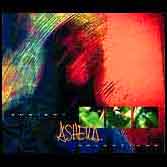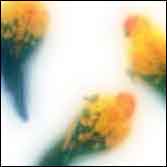|
Ashera, with their third release on the label of the same name, continues their ability to build sonic worlds within this listener's mind.
"Colour Glow" contains eleven tracks of pure sonic bliss which lend themselves to repeated playback of similar yet different soundscapes of engagingly sculpted musical métier.
Where the "Cobalt 144" release utilized the soundscape to draw the listener into itself and painted sonic intimation, or eminent guideposts, to the journey that unfolded before you. Colour Glow envelops you in wave after wave of supportive layers that wash and undulate around you and finally embrace and begin to move your senses outward.
By the end of "Savannah Mirage", the opening track, the sonic imagery is so large and enveloping that a vision of paradise materializes around your entire being&ldots; and then vanishes as the mists of a mirage so aptly do. Those blessed with adroit sensory skills may never even feel the sense of loss of the unattainable as the transportation through the space time continuum immediately soothes the sonic soul as the "Mist Well" appears.
I achieved the sensations of standing before a well, enshrouded by mist, surrounded by the very mirage of an oasis or paradise that I thought was washed away. The opening tracks deftly carved a vision state and then transported me within my minds own eye into a land of wondrous vision. A startling and uncanny sonic manipulation&ldots; truly possessing the resourcefulness to take you there.
The third track, "Two Moons", contains real world nature sound sources as a layered bed for the tone palette of a full bodied Fender Rhodes keyboard laced minimalist structure which evokes the presence of watchful heavenly bodies appearing overhead.
The title track weighs in as the fourth offering, in a long form piece, that is swimmingly saturated in luxuriously cascading reverb tales appearing as a blissfully erotic vignette of what I saw and heard as the Daughters of the Twin Moons. Silvery, lilting, tendril like vocalizations by the ethereal twin children of the moon weaving autochthonous, alluring, chordal harmonies throughout ones very fiber.
Introspective reflection, and a wondrous journey, through the complete sensory ramifications of "Colour" abound in the following tracks of "Colour Glow". I hesitate to even share an expeditious synopsis of the rest of my journey through the world of "Colour Glow" and would rather submit to you that this is the pinnacle of Ambient Visions for this writer since receiving this latest offering from the land down under. Consider this
juncture an open invitation to immerse yourself in a visionary sonic journey of the highest caliber.
There are enough of the underlying qualities of the four elements contained in the works of Antonio Wright, Caroline Wilson, and Adriana Korkosova for me to state that I rank "Colour Glow" as one of the two quintessential Ambient releases, known to me, at the present time. The other is their previous release "Cobalt 144", also on Ashera. These two releases are the definition of perfectly exemplifying the quality of the fifth and highest essence
present in all things as suggested by ancient and medieval philosophy. At the very least, in my sonic world, it works for me.
My highest recommendation for inclusion in every collection, without any reservation whatsoever, as I consider "Colour Glow" the Ambient Release of the Year for 2000.
Reviewed by BEAR 01.07.01
Audiophiles Note: Although this recording will not dynamically tax your system as this and the previous Ashera release continues Antonio's conviction to playback at lower levels. "Colour Glow" has a lower output level, than the currently accepted standard, which enables his wish, although you may persist and push the envelope on your own, you will still hear exactly what the artists vision is.
It is possible that the significant difference between "Colour Glow" and "Cobalt 144" is in the production and mixing itself. You may recall that I suggested earlier that one draws you in while the other envelops and transports. On both the Holo-System and the Stax electrostatic headphones the "Colour Glow" effect is achieved by the use of panoramic panning techniques. By this I refer to the interaction between left and right channels
in all aspects of the mix as a significant portion of the layers reside in the panoramic staging and seldom enter the foreground or reside center stage as a focal point. No single sound or element takes precedence over the others as one finds them sharing the same space and then morphing gracefully across the soundstage. This is a must listen recording for headphone aficionado's offering truly astounding sonics for those with a headphone system capable of resolving inner detail and the depth of layered
effects. Final note: Least anyone read this expecting a special effects spectacular rest assured that there is significant melodic content in this work although the "sonic voice" carrying that melody has a consistent habit of morphing into another sonic signature or "sonic voice".
There is also, and not at all detrimental, a lack of visceral low end, which oddly enough is only missing if you listen for it. The individual layers and their composite morphing are amazingly present in both room speakers and headphones. "Colour Glow's" ability to envelop and become part of or one with the room is in itself a testament to the quality of the artists craft.
The listening session were performed in the following systems:
(1) Electrocompaniet EMC-1 CD player, Electrocompaniet ECI-3 Integrated, Magneplanar MG1.6QR, & Sunfire True Subwoofer speakers.
(2) Linn Classik into Stax Electrostatic SRX MkIII & Sennheiser HD600 headphones.
(3) The Holo-System: Rega Planet 2000, Belles XLM preamplifier, Belles 200 power amplifier and Altec Lansing 510 A speakers. ( A relatively large system in an extremely small room with only one small holographic listening sweet spot) |







